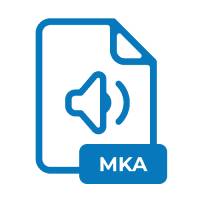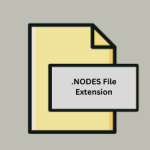.MKA File Extension

Matroska Audio
| Developer | Matroska |
| Popularity | |
| Category | Audio Files |
| Format | .MKA |
| Cross Platform | Update Soon |
What is an MKA file?
Matroska Audio files, denoted by the .MKA file extension, belong to the Matroska Multimedia Container format. Unlike traditional audio file formats, Matroska Audio is part of a versatile container that can hold various types of multimedia data, including audio, video, and subtitles. This file extension is specifically used for Matroska containers that exclusively contain audio streams.
More Information.
Matroska Audio files were introduced to address the limitations of existing multimedia container formats. The project aimed to create a modern, extensible, and open-source container that could house various types of multimedia streams, supporting advanced features such as chapters, menus, and selectable audio and subtitle tracks.
The primary goal was to create a format that could be universally adopted without the restrictions of proprietary technologies.
Origin Of This File.
The Matroska project originated in Russia and was named after the Russian nesting dolls, “Matryoshka,” symbolizing the idea of containers within containers.
The Matroska Multimedia Container format, including its audio variant, was developed to provide a flexible and open standard for storing multimedia content.
File Structure Technical Specification.
Matroska Audio files follow a container-based structure, allowing the encapsulation of one or more audio streams along with metadata, chapters, and other multimedia components.
The technical specifications of Matroska Audio include support for a wide range of audio codecs, making it a versatile choice for storing high-quality audio data.
The format is based on open standards, enabling developers to implement Matroska support in their applications without licensing constraints.
How to Convert the File?
How to Convert the File on Windows:
Converting Matroska Audio files on Windows is a straightforward process, and you can use various software tools for this purpose. One popular option is using the versatile VLC Media Player. Here’s a step-by-step guide:
- Download and Install VLC Media Player: If you don’t have VLC installed, download and install it from the official website (https://www.videolan.org/vlc/index.html).
- Open VLC Media Player: Launch VLC on your Windows system.
- Go to “Media” Menu: Click on the “Media” menu in the top-left corner of the VLC window.
- Choose “Convert/Save…”: From the drop-down menu, select “Convert/Save…” option.
- Add the Matroska Audio File: Click on the “+ Add” button and select the Matroska Audio file you want to convert.
- Choose Output Format: At the bottom, select the desired output format from the dropdown list.
- Set Destination File: Click on the “Browse” button to choose the destination folder for the converted file.
- Start Conversion: Press the “Start” button to begin the conversion process. Once completed, you will find the converted file in the specified destination.
How to Convert the File on Linux:
On Linux, you can use the powerful FFmpeg tool for converting Matroska Audio files. Here’s a step-by-step guide using the command line:
- Install FFmpeg: If you don’t have FFmpeg installed, you can install it using your package manager. For example, on Debian-based systems.
- Open Terminal: Launch the terminal on your Linux system.
- Navigate to the File Location: Use the
cdcommand to navigate to the directory containing the Matroska Audio file. - Run FFmpeg Command: Use the following command to convert the file to a different format. Replace “output.mp3” with your desired output file name and format.
How to Convert the File on Mac:
On Mac, you can use applications like HandBrake for converting Matroska Audio files. Here’s a step-by-step guide:
- Download and Install HandBrake: If you don’t have HandBrake installed, download and install it from the official website (https://handbrake.fr/).
- Open HandBrake: Launch HandBrake on your Mac.
- Click “Open Source”: Click on the “Open Source” button and select the Matroska Audio file you want to convert.
- Choose Output Format: In the “Presets” section, select the desired output format.
- Set Destination File: Specify the destination folder and file name for the converted file.
- Start Conversion: Click on the “Start” button to begin the conversion process. Once completed, you will find the converted file in the specified destination.
How to Convert the File on Android:
Converting Matroska Audio files on Android can be done using various apps. One popular choice is using VLC for Android. Here’s a simple guide:
- Download and Install VLC for Android: Install VLC for Android from the Google Play Store.
- Open VLC: Launch the VLC app on your Android device.
- Navigate to the Matroska Audio File: Locate and open the Matroska Audio file you want to convert using the VLC app.
- Choose Conversion Format: Tap on the three dots in the top-right corner, go to “Tools,” and select “Convert.”
- Select Output Format: Choose the desired output format for conversion.
- Start Conversion: Press the “Start” button to initiate the conversion process. Once completed, you can find the converted file in the specified destination.
How to Convert the File on iOS:
Converting Matroska Audio files on iOS involves using third-party apps available on the App Store. One popular app for this purpose is VLC for Mobile. Here’s a step-by-step guide:
- Download and Install VLC for Mobile: Install VLC for Mobile from the App Store.
- Open VLC: Launch the VLC app on your iOS device.
- Import Matroska Audio File: Tap on the VLC cone icon at the top left, go to “Sharing via WiFi,” and upload the Matroska Audio file to the VLC app.
- Choose Conversion Format: Go to the “Media Library” in VLC, find your imported file, and tap on it. Then, select “Convert” from the menu.
- Select Output Format: Choose the desired output format for conversion.
- Start Conversion: Press the “Start” button to begin the conversion process. Once completed, you can find the converted file in the VLC app’s media library.
Advantages And Disadvantages.
Advantages:
- Versatility: Matroska Audio files can contain various types of audio streams, making them suitable for diverse multimedia projects.
- Open Standard: Being an open-source format, Matroska encourages widespread adoption and compatibility across different platforms and software.
- Rich Features: The format supports advanced features like chapters, menus, and multiple audio tracks, enhancing user experience and content presentation.
Disadvantages:
- Compatibility: While support for Matroska has increased, some older or specialized software may not fully support this format.
- File Size: Depending on the chosen audio codec and settings, Matroska Audio files may have larger file sizes compared to some other audio formats.
- Complexity: The flexibility of Matroska can lead to complexity in handling, especially for users unfamiliar with multimedia containers.
How to Open MKA?
Open In Windows
Several multimedia players and converters for Windows, such as VLC Media Player and Freemake Video Converter, support Matroska Audio files seamlessly. Simply open the file using the chosen software.
Open In Linux
Linux users can rely on native multimedia players like VLC or use command-line tools like FFmpeg for handling Matroska Audio files.
Open In MAC
Mac users can use popular media players like VLC or convert the files using software like HandBrake, which supports Matroska Audio.
Open In Android
For Android devices, numerous media player apps, such as VLC for Android or MX Player, can play Matroska Audio files without any hassle.
Open In IOS
iOS users can use third-party media player apps available on the App Store that support Matroska Audio, providing a seamless playback experience.
Open in Others
For other platforms, cross-platform media players like VLC or multimedia conversion tools like FFmpeg ensure compatibility with Matroska Audio files.













